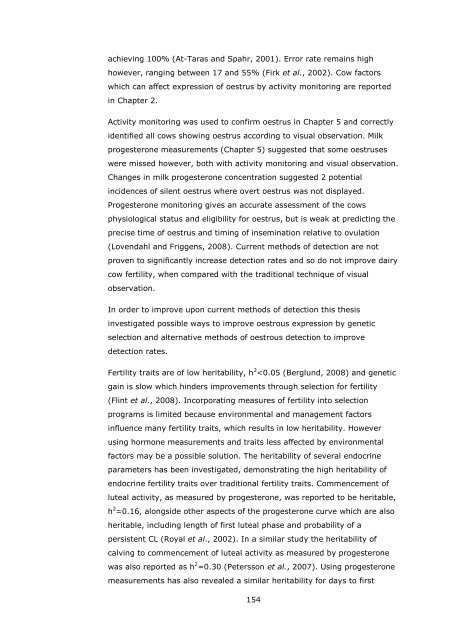novel approaches to expression and detection of oestrus in dairy cows
novel approaches to expression and detection of oestrus in dairy cows
novel approaches to expression and detection of oestrus in dairy cows
Create successful ePaper yourself
Turn your PDF publications into a flip-book with our unique Google optimized e-Paper software.
achiev<strong>in</strong>g 100% (At-Taras <strong>and</strong> Spahr, 2001). Error rate rema<strong>in</strong>s high<br />
however, rang<strong>in</strong>g between 17 <strong>and</strong> 55% (Firk et al., 2002). Cow fac<strong>to</strong>rs<br />
which can affect <strong>expression</strong> <strong>of</strong> <strong>oestrus</strong> by activity moni<strong>to</strong>r<strong>in</strong>g are reported<br />
<strong>in</strong> Chapter 2.<br />
Activity moni<strong>to</strong>r<strong>in</strong>g was used <strong>to</strong> confirm <strong>oestrus</strong> <strong>in</strong> Chapter 5 <strong>and</strong> correctly<br />
identified all <strong>cows</strong> show<strong>in</strong>g <strong>oestrus</strong> accord<strong>in</strong>g <strong>to</strong> visual observation. Milk<br />
progesterone measurements (Chapter 5) suggested that some <strong>oestrus</strong>es<br />
were missed however, both with activity moni<strong>to</strong>r<strong>in</strong>g <strong>and</strong> visual observation.<br />
Changes <strong>in</strong> milk progesterone concentration suggested 2 potential<br />
<strong>in</strong>cidences <strong>of</strong> silent <strong>oestrus</strong> where overt <strong>oestrus</strong> was not displayed.<br />
Progesterone moni<strong>to</strong>r<strong>in</strong>g gives an accurate assessment <strong>of</strong> the <strong>cows</strong><br />
physiological status <strong>and</strong> eligibility for <strong>oestrus</strong>, but is weak at predict<strong>in</strong>g the<br />
precise time <strong>of</strong> <strong>oestrus</strong> <strong>and</strong> tim<strong>in</strong>g <strong>of</strong> <strong>in</strong>sem<strong>in</strong>ation relative <strong>to</strong> ovulation<br />
(Lovendahl <strong>and</strong> Friggens, 2008). Current methods <strong>of</strong> <strong>detection</strong> are not<br />
proven <strong>to</strong> significantly <strong>in</strong>crease <strong>detection</strong> rates <strong>and</strong> so do not improve <strong>dairy</strong><br />
cow fertility, when compared with the traditional technique <strong>of</strong> visual<br />
observation.<br />
In order <strong>to</strong> improve upon current methods <strong>of</strong> <strong>detection</strong> this thesis<br />
<strong>in</strong>vestigated possible ways <strong>to</strong> improve oestrous <strong>expression</strong> by genetic<br />
selection <strong>and</strong> alternative methods <strong>of</strong> oestrous <strong>detection</strong> <strong>to</strong> improve<br />
<strong>detection</strong> rates.<br />
Fertility traits are <strong>of</strong> low heritability, h 2
















